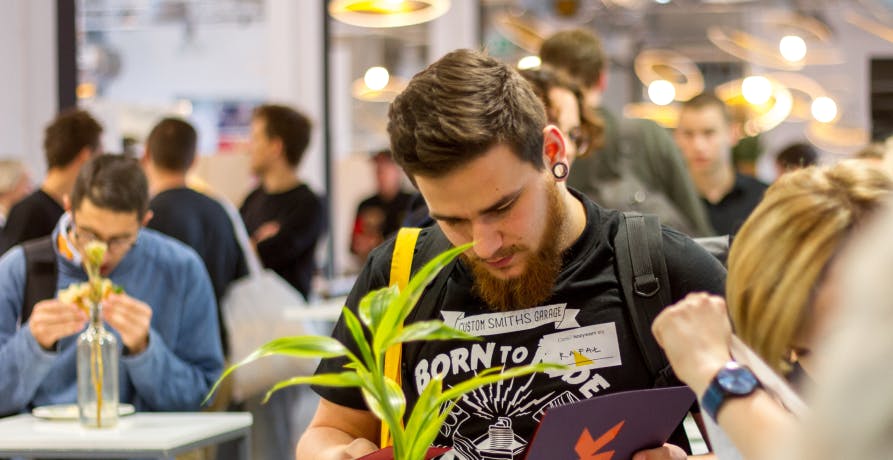ESG / CSR
Industries
5 Tips to Reduce the Carbon Footprint of your Events



Whether it’s a conference, the company Christmas party, or a business specialising in organising events on a daily basis, it can be easy to forget, or even push aside, environmental considerations in favour of having a good time! But just like every other part of a business’ operations, events are something that need to be considered when it comes to sustainability and environmental impact.
👉 In this article we’ll explore the impact of events on the environment, and look at 5 ways companies can reduce the carbon footprint of their events.
Just how bad for the environment is an event?
The event industry as a whole is responsible for as much as 10% of global greenhouse gas emissions! From the materials used, to the energy consumed, to the transport required for participants to access the venue, the resulting carbon footprint can be significant.
And it’s not just the events industry who is responsible for significant carbon emissions. Take a relatively small scale conference for example. Research shows that the average conference attendee creates around 176.67 KG of CO2 emissions and produces 1.89 KG of discarded waste per day - of which 1.16 KG will end up in the landfill. This means that a three day, 1000 person conference will result in 530 metric tons of CO2e (the equivalent of 1233 barrels of oil!) and will produce a total of 5670 KG of waste, 3480 KG of which will end up in the landfill.
It’s clear therefore that environmental sustainability is something that needs to be applied to event planning - whether your company operates in the events industry or not.
So what can companies do to reduce the carbon footprint of their events?

Identify the areas that contribute the most to the event’s carbon footprint
Before we get into the detail on how a company can reduce the emissions of their event, it’s important to note that the first step is always awareness - companies need to know just how much of an impact they’re having in order to effectively cut down, and this is no different when it comes to running an event. By establishing what activities or aspects of the event are responsible for the largest carbon footprint, companies can then take the necessary steps to cut down on emissions and reduce their environmental impact. This will also allow a company to effectively measure the impact of their sustainability actions.
Take steps to cut down on the events carbon footprint
Once a company has established what aspects of their event are the most carbon intensive they should look to implement a strategy to cut down on emissions. What this strategy will be should be tailored according to the type of event being organised, but in this section we’ll look at some general actions that can have a big impact on the environment.
1. Travel
The average event attendee is responsible for consuming around 175.67 KG a day, but this can reach up to almost 1000 KG where significant travel is required. Travel might mean international flights, or it might mean taking taxis to and from the event. Depending on the type of travel, companies can then take appropriate steps to cut down on emissions. For example where international travel is required, it might be that employees or event attendees are given the option of joining remotely, thereby cutting out the need for travel altogether. Or where the attendees are local, companies can look to organise collective transport to cut down on personal car use and individual taxis - for example a bus that collects employees from the office, and drops them off again after the event is over.

2. Waste
The majority of waste produced by an event ends up in a landfill. This will usually be made up of things like food waste, printed marketing materials, brochures and agendas, plastic water cups, coffee cups etc. In order to tackle unnecessary wastage at events, companies need to ensure that reusable alternatives are being used as much as possible (for example, washable cutlery, glasses and plates), and that where this is not an option, products made from recycled materials should be selected over non-recycled ones. Clear and obvious recycling facilities at the actual event can also help to cut down on landfill waste - make it as easy as possible for attendees to correctly dispose of their waste with easy to access recycling points and clear signage.
Another way to reduce waste is to go digital. Instead of printing out the event’s agenda and brochures, they can be posted on the event website (you could also make an event app!). Digital tickets are another example of how an event organiser can cut down on printing - and save money on printing costs!

3. Food
The food and beverage industry is responsible for almost 30% of greenhouse gas emissions globally, but what this statistic doesn’t show is that some produce is more carbon intensive than others. Meat and dairy products are the biggest culprits when it comes to environmental impact. This is why when catering for an event, companies can have a positive impact on carbon emissions by simply selecting low-impact food options such as vegetarian options, dairy free alternatives, or choosing menus with meat like chicken instead of beef.
Event organisers should also try to work with food suppliers who employ their own sustainability practices. Buying local produce that is in-season is a great way to reduce the carbon footprint of the food being served and support local businesses.
It’s also important to consider how you’re serving the food and drink at the event - are you using single-use plastic cups, straws and other non-reusable utensils? A lot of these products can’t be recycled which means they end up in our landfills. By switching to biodegradable options, reusable cutlery and serving drinks in jugs instead of plastic bottles, you can very easily cut down on your environmental impact.

4. Venue
The carbon footprint of the venue is around 4% of the event’s total carbon footprint, which may seem pretty inconsequential, however, it can also represent an easy way to cut down on carbon emissions. By switching to a venue that uses renewable energy to power its facilities, you’ll be having an immediate impact on the environment. Other aspects to look out for when selecting a venue include, does the facility employ sustainability practices such as recycling facilities, LED light sources, and does it offer technological facilities to allow attendees to attend virtually?
Another consideration when planning an event should be how easily accessible the venue actually is. A venue that is in the city centre with lots of public transport options is a more sustainable alternative than a venue that is in the middle of the countryside requiring taxis to reach it. If the event spans multiple days, it will also be necessary to consider accommodation - is there a hotel nearby, or will attendees be required to commute some distance to reach their accommodation?

5. Eco-friendly goods
Many events give away promo products (just think of all the free pens and notebooks they hand out at conferences) - it offers brands a chance to boost their profile, and people generally love to get free stuff! However, this practice results in a lot of waste. Event organisers should also ask themselves whether it’s really necessary. If it’s not something that can be cut out altogether, companies should consider how they can make this practice as environmentally friendly as possible. This can be achieved by selecting goods that are made from recycled materials and by opting to work with local producers or suppliers (something that will help to cut down on transport emissions). Or why not give out freebies that have a positive impact on the environment - for example reusable coffee cups are a sustainable alternative to disposable ones, and by printing your brand name on the side, you’ll also be raising brand awareness.
Another point to consider is the event decor. This is something that can also easily be made from recycled materials. In fact, there are even environmentally-friendly event decor companies who can help you with this.

What about emissions that can’t be reduced?
Unfortunately, despite best efforts, it’s not always possible to completely eliminate carbon emissions. In the situation where a company has made every effort to reduce their emissions, but still finds that their event isn’t carbon neutral, they can instead look to offset their emissions.
The voluntary carbon market allows companies to purchase carbon credits, allowing them to offset their carbon emissions by supporting projects around the world that seek to reduce greenhouse gas emissions. Why not take a look at our article on the Voluntary carbon market and how this can help in the fight against global warming.
Round-up
Event planning isn’t excluded from a company’s efforts to implement sustainable practices and reduce carbon emissions. And it’s absolutely possible to organise enjoyable, successful events while also protecting the planet. Whether it’s a company that specialises in event planning or simply a one-off company event, organisers should adopt sustainability practices at every stage of the process - from planning, to venue selection to on-site waste management. By adopting a holistic approach to the organisation of the event, planners can make sure that the carbon footprint is minimal.

What about Greenly?
At Greenly we can help you to assess your company’s carbon footprint, and then give you the tools you need to cut down on emissions. Why not request a free demo with one of our experts - no obligation or commitment required.
If you’d like to learn more about a specific industry, Greenly can help by providing an in-depth industry study, created by our climate scientists.


